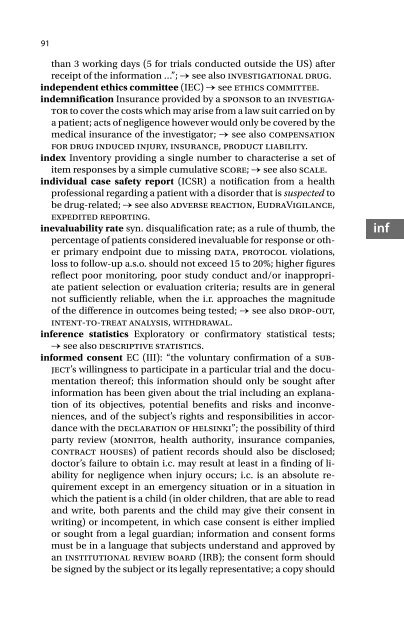220-Dictionary of Pharmaceutical Medicine, 2nd Edition-Gerhard Nahler Annette Mollet-3211898352-S
220-Dictionary of Pharmaceutical Medicine, 2nd Edition-Gerhard Nahler Annette Mollet-3211898352-S
220-Dictionary of Pharmaceutical Medicine, 2nd Edition-Gerhard Nahler Annette Mollet-3211898352-S
You also want an ePaper? Increase the reach of your titles
YUMPU automatically turns print PDFs into web optimized ePapers that Google loves.
91than 3 working days (5 for trials conducted outside the US) afterreceipt <strong>of</strong> the information …”; → see also investigational drug.independent ethics committee (IEC) → see ethics committee.indemnification Insurance provided by a sponsor to an investigatorto cover the costs which may arise from a law suit carried on bya patient; acts <strong>of</strong> negligence however would only be covered by themedical insurance <strong>of</strong> the investigator; → see also compensationfor drug induced injury, insurance, product liability.index Inventory providing a single number to characterise a set <strong>of</strong>item responses by a simple cumulative score; → see also scale.individual case safety report (ICSR) a notification from a healthpr<strong>of</strong>essional regarding a patient with a disorder that is suspected tobe drug-related; → see also adverse reaction, EudraVigilance,expedited reporting.inevaluability rate syn. disqualification rate; as a rule <strong>of</strong> thumb, thepercentage <strong>of</strong> patients considered inevaluable for response or otherprimary endpoint due to missing data, protocol violations,loss to follow-up a.s.o. should not exceed 15 to 20%; higher figuresreflect poor monitoring, poor study conduct and/or inappropriatepatient selection or evaluation criteria; results are in generalnot sufficiently reliable, when the i.r. approaches the magnitude<strong>of</strong> the difference in outcomes being tested; → see also drop-out,intent-to-treat analysis, withdrawal.inference statistics Exploratory or confirmatory statistical tests;→ see also descriptive statistics.informed consent EC (III): “the voluntary confirmation <strong>of</strong> a subject’swillingness to participate in a particular trial and the documentationthere<strong>of</strong>; this information should only be sought afterinformation has been given about the trial including an explanation<strong>of</strong> its objectives, potential benefits and risks and inconveniences,and <strong>of</strong> the subject’s rights and responsibilities in accordancewith the declaration <strong>of</strong> helsinki”; the possibility <strong>of</strong> thirdparty review (monitor, health authority, insurance companies,contract houses) <strong>of</strong> patient records should also be disclosed;doctor’s failure to obtain i.c. may result at least in a finding <strong>of</strong> liabilityfor negligence when injury occurs; i.c. is an absolute requirementexcept in an emergency situation or in a situation inwhich the patient is a child (in older children, that are able to readand write, both parents and the child may give their consent inwriting) or incompetent, in which case consent is either impliedor sought from a legal guardian; information and consent formsmust be in a language that subjects understand and approved byan institutional review board (IRB); the consent form shouldbe signed by the subject or its legally representative; a copy shouldinf


